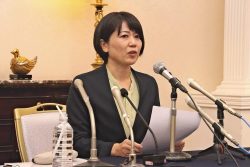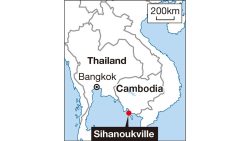
Paleontologist Yoshitsugu Kobayashi
12:00 JST, April 5, 2024
Yoshitsugu Kobayashi, a renowned and a professor paleontologist and a deputy director at the Hokkaido University Museum, is nicknamed “Falcon’s Eye” due to his successive discoveries of dinosaur fossils. He also played a major role as an advisor for the movie “Kyoryu-cho-densetsu2: Gekijoban Darwin ga Kita!” (Dinosaur super legend2: Darwin’s Amazing Animals theatrical edition), which explores the period following an asteroid impact believed to have caused the dinosaurs’ extinction.
How did Kobayashi, fascinated by castles and Buddha statues as a child, become a world-famous paleontologist?
Digging for ‘treasure’
Kobayashi was born in 1971 in Fukui Prefecture, which was renowned nationwide for its dinosaur fossil findings. However, Kobayashi was more fascinated by castles, Buddha statues, temples and ancient tombs in his childhood rather than by dinosaurs.
Nonetheless, finding a fossil during a science club activity in junior high school set him on the path to becoming a paleontologist. During the activity, he discovered an ammonite after breaking open a stone with a hammer and was thrilled by the realization that he was holding right in his hands a creature that lived 150 million years ago.
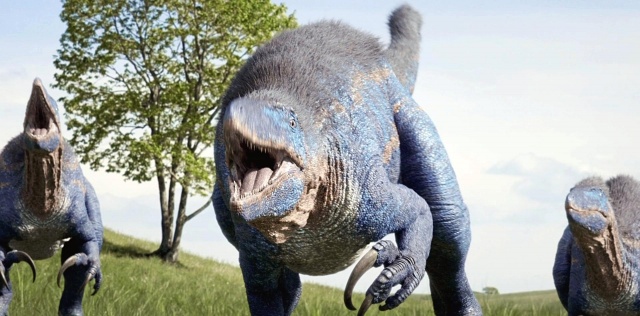
Threatening Maip dinosaurs
“As a child, I think that I was attracted to feeling the flow of time, whether it was through castles, which were made by people who lived hundreds of years ago, or fossils, which were the remains of creatures that lived more than 100 million years ago,” Kobayashi said.
Since then, Kobayashi often went fossil hunting. However, he said, “I didn’t understand evolution well and disliked biology.” For him, digging for fossils was like a treasure hunt. He considered excavating fossils merely a hobby and had a vague thought of becoming a company employee in the future.
After entering university, though, he started to feel troubled. He went to the United States for a year of language study by chance, which only intensified his anxiety and impatience about the future.
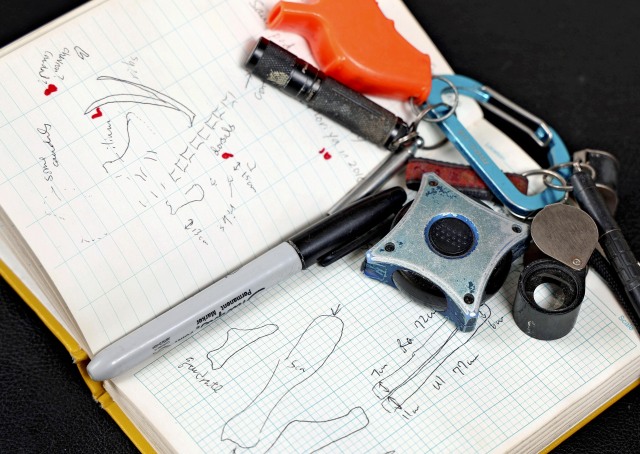
Tools that Kobayashi brings to his dinosaur excavation
“What do I really want to do?” Kobayashi wondered. At a time when he felt he was losing sight of himself, he picked up a dinosaur encyclopedia in the university library on a whim. As he looked through it, the excitement he felt touching the lives of creatures from the distant past through fossils came flooding back.
“I want to learn about dinosaurs. I’ll go to America once again,” Kobayashi thought. Three months after coming back from his study abroad, he returned to the United States.
A turning point
Kobayashi graduated from the University of Wyoming with the highest honors and advanced placement due to his relentless effort and mastery in study techniques. However, he faced challenges at Southern Methodist University’s graduate school, which he entered after overcoming a 50-to-1 competition ratio. No matter how much research he compiled, it was constantly rejected by his professors, and he struggled to gain their approval.
“I realized that having knowledge and knowing how to apply it to create something are worlds apart. Studying and research are not the same,” Kobayashi said.

A battle between a colossal herbivorous Puertasaurus, rear, and a giant carnivorous Maip.
He thought, “I should just go back to Japan,” many times while continuing to try different approaches. One day, a professor who listened to his presentation applauded and exclaimed, “Great!”
“I believe it was at that moment that I transitioned from a student to a researcher,” Kobayashi recalled.
Since then, Kobayashi has discovered new and valuable dinosaur fossils worldwide, including in Mongolia, the state of Alaska and China. In the Gobi Desert of Mongolia, he discovered the complete skeleton of a Deinocheirus, known as the mystery dinosaur. In Mukawa, Hokkaido, he unearthed the complete skeleton of a large herbivorous dinosaur from the end of the Cretaceous period, which was the first found in Japan. He has also published research that challenged previous theories. For example, he revealed that among theropods, which were considered carnivorous, there were herbivorous species.
Humanity in danger
Various studies have clearly shown that some dinosaurs evolved into birds. “In the past, dinosaurs were thought to be dumb monsters that had gone extinct. However, these creatures that once walked the land underwent a sea change, achieving an incredible evolution into birds that even dominate gravity,” Kobayashi said. “It’s dinosaurs that have left us all these records.”

A Puertasaurus looks up at the sky.
While involved in research and writing, as well as in the operations of the Hokkaido University Museum, he spends several months of the year abroad on excavation surveys, becoming immersed in the world of dinosaurs.
“For me, dinosaurs have become a part of life. When I go on surveys or start research, my body moves without thinking. I guess that’s probably because I like them so much,” he said.
The movie Kobayashi served as an advisor for depicts the struggle of dinosaurs trying to desperately survive after the asteroid impact. Although such a story is an event from the distant past, the truth is that we are currently living in an era where species are going extinct at an unprecedented rate, he said. The cause is not meteorites, but human activity.
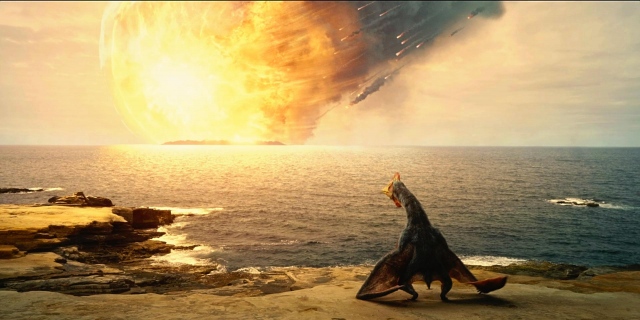
The moment of an asteroid impact
“We, humanity, are actually in a very dangerous state,” Kobayashi said. Understanding dinosaurs is also connected to knowing about the future of the Earth and humanity. This strong belief urges him to conduct his research.
“The keyword in dinosaur research now is resurrection. It’s exciting to see more and more research coming out, enabling [researchers] to restore the original, real appearance of dinosaurs,” Kobayashi said.
Despite being a leading researcher in this field, Kobayashi does not seem to feel pressured. While on an excavation in Uzbekistan last summer, Kobayashi competed with his students to find fossils every day.
“I ended up winning, and my students called me childish,” he said. The moment Kobayashi recounted this, his sharp “falcon eyes” softened.
Dinosaurs come to life in high-definition CGI
“Kyoryu-cho-densetsu2: Gekijoban Darwin ga Kita!” is the fifth movie of NHK’s popular nature program “Darwin ga Kita!” (“Darwin’s Amazing Animals”), which airs Sunday nights. It is set 66 million years ago on Gondwana, an ancient supercontinent. Life and death battles for survival unfolded there among dinosaurs like the colossal herbivore Puertasaurus, the giant carnivore Maip and the horned Carnotaurus, all using their wits to survive living and producing offspring.
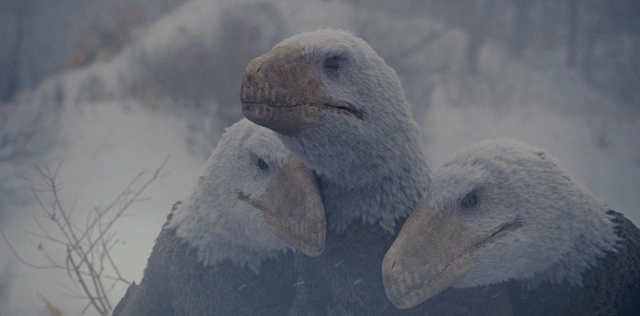
Dinosaurs living in the harsh environment following an asteroid impact
The film also illustrates dinosaurs desperately struggling to survive amid fires and a cooling global environment caused by an asteroid impact. Unknown aspects surrounding dinosaurs, which were revealed by the latest research, are portrayed in compelling high-definition CGI.
Related Tags
"Culture" POPULAR ARTICLE
-

Van Cleef & Arpels Dazzles with Art Deco Artisanry at Tokyo Exhibit
-

Disney’s ‘Twisted-Wonderland’ Animated Series Puts Villains in Spotlight: New Show Features School Inspired by Classic Disney Films
-

Japan Plans to Distribute Manga Overseas Via New Platform
-

Japanese Craftsman Produces Beautiful and Durable Bags Made of Wood
-

Ayumi Hamasaki’s Shanghai Concert Canceled Day Before Schedule as Part of Beijing Backlash
JN ACCESS RANKING
-

Keidanren Chairman Yoshinobu Tsutsui Visits Kashiwazaki-Kariwa Nuclear Power Plant; Inspects New Emergency Safety System
-

Imports of Rare Earths from China Facing Delays, May Be Caused by Deterioration of Japan-China Relations
-

Japan Exports Rise in October as Slump in U.S. Sales Eases
-

Govt Aims to Expand NISA Program Lineup, Abolish Age Restriction
-

Blanket Eel Trade Restrictions Rejected












